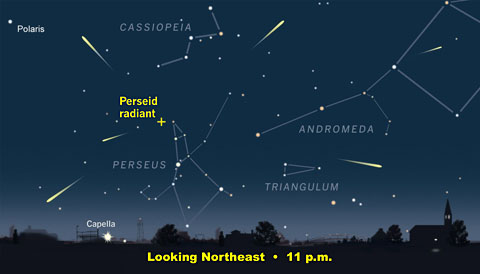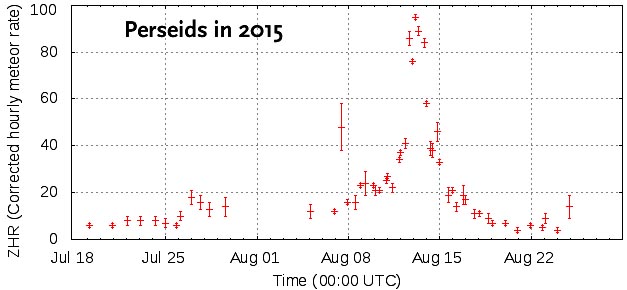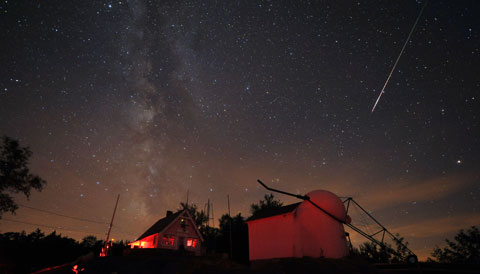After the Moon sets on August 11–12, the Perseid meteor shower could be unusually rich.
The Perseid meteor shower is the most anticipated annual celestial event worldwide. Every August, when Earth crosses the orbit of Comet 109P/Swift-Tuttle, bits of dusty debris scattered along its orbit slam into Earth's atmosphere at 37 miles (60 km) per second. Each of these creates a quick, white-hot streak of superheated air — a meteor.
(If you're curious about what these meteor-shower particles look like, the nuggets in Grape Nuts cereal are a close match to their estimated size, color, and texture.)
In a typical year, when looking into a very dark, moonless sky, you might expect to see about 60 to 90 Perseids per hour late on the night of the shower's maximum. This year the peak should come late Thursday night, August 11th, and last through the early-morning hours of the 12th.
Where and How to Look

Sky & Telescope illustration
So why don't we call these meteors the "Swift-Tuttlids"? Great question! It's known instead as the Perseids because the meteors all seem to radiate across the sky from the direction of the constellation Perseus. This apparent point of origin, called the radiant, is actually just a trick of perspective.
But you don't need to look at the radiant to spot a Perseid meteor because they can appear anywhere and everywhere in the sky. So the best direction to watch is wherever your sky is darkest, and that's usually straight up. Faint Perseids appear as tiny, quick streaks. Occasional brighter ones may sail across the heavens for several seconds and leave a brief train of glowing smoke.

International Meteor Org.
Begin watching for them soon after evening twilight ends. By then the shower's radiant has risen above the northeastern horizon. The few Perseids that appear this early will be spectacularly long "Earthgrazers" that skim along the top of the atmosphere.
The higher the radiant is in the sky, the more meteors you'll see, and it's highest in the hours before dawn. Typically you can see about 1 Perseid per minute near the peak if you have a dark, Moonless sky.
Speaking of the Moon, another reason to stay up late is that light from the waxing gibbous Moon, just one day past first-quarter phase, will hinder the viewing slightly. But it should set about 1 a.m.
A Bonus Year for the Perseids?
Comet Swift-Tuttle's orbit extends way out, far beyond the orbit of Pluto, and about every 12 years Jupiter passes near it. Each time that happens (most recently in November 2014), the giant planet's gravity tugs the particles passing by at the time, pushing them closer to Earth's orbit than they otherwise would. Those perturbed particles are due to arrive in Earth's vicinity this year — so get ready for what might be a bumper crop of shooting stars.

J. Kelly Beatty
Dynamicist Mikhail Maslov predicts that the maximum Perseid rate will be roughly double the usual — but that the peak will come during daylight hours for North America. He suggests that other strands of debris, some ejected by the comet as long ago as 1479, might also collide with Earth. The upshot is that in the hours just before and after 23 UT on August 11th (well placed for Europe but only 7 p.m. EDT) we might get a secondary boost of 10 to 20 meteors per hour above the background rate.
Meanwhile, French meteor expert Jérémie Vaubaillon predicts an enhanced peak around 1 a.m. EDT on August 12th — generally good for North America and ideal for those on the East Coast.
No Equipment Needed
To enjoy the Perseid meteors, you need no equipment but your eyes. Find a dark spot with a wide-open view overhead. Bring a reclining lawn chair or a ground cloth so you can lie back and watch the sky in comfort. Bundle up in blankets or a sleeping bag, both for mosquito shielding and for warmth; clear nights can grow surprisingly chilly under the open stars (due to radiational cooling).
If you're planning to try your hand at photographing the Perseids, all you really need is a camera. Get advice from S&T contributing editor Jerry Lodriguss here: "How to Photograph a Meteor Shower".

Sky & Telescope / Dennis di Cicco
Occasionally you might spot an interloper. The weaker Delta Aquariid and Kappa Cygnid showers are also active during Perseid season, and there are always a few random, “sporadic” meteors. All of these track back to other parts of the sky. Any light pollution will cut down the numbers visible. But the brightest few meteors shine right through light pollution. So enjoy the show!
And if it's cloudy on the night of August 11–12? Don't fret. First of all, the shower produces plenty of meteors for at least a week before and after this date. Second, you can always tune in to a webcast provided by someone in the clear. For example, the astronomers at Bareket Observatory in Israel invite you to join them on both August 11th and 12th beginning at 19:00 UT (3 p.m. EDT). The team at Slooh is also webcasting live, beginning at 8 p.m. EDT on August 11th.
 1
1
Comments
Mike
August 11, 2016 at 7:58 am
Question: If "To enjoy the Perseid meteors, you need no equipment but your eyes", why did I receive an email from S&T this morning (August 11) telling me I could "See the Perseid Meteor Shower Up Close!" when I "Save an Extra $5 on Binocular Highlights"?
You must be logged in to post a comment.
You must be logged in to post a comment.